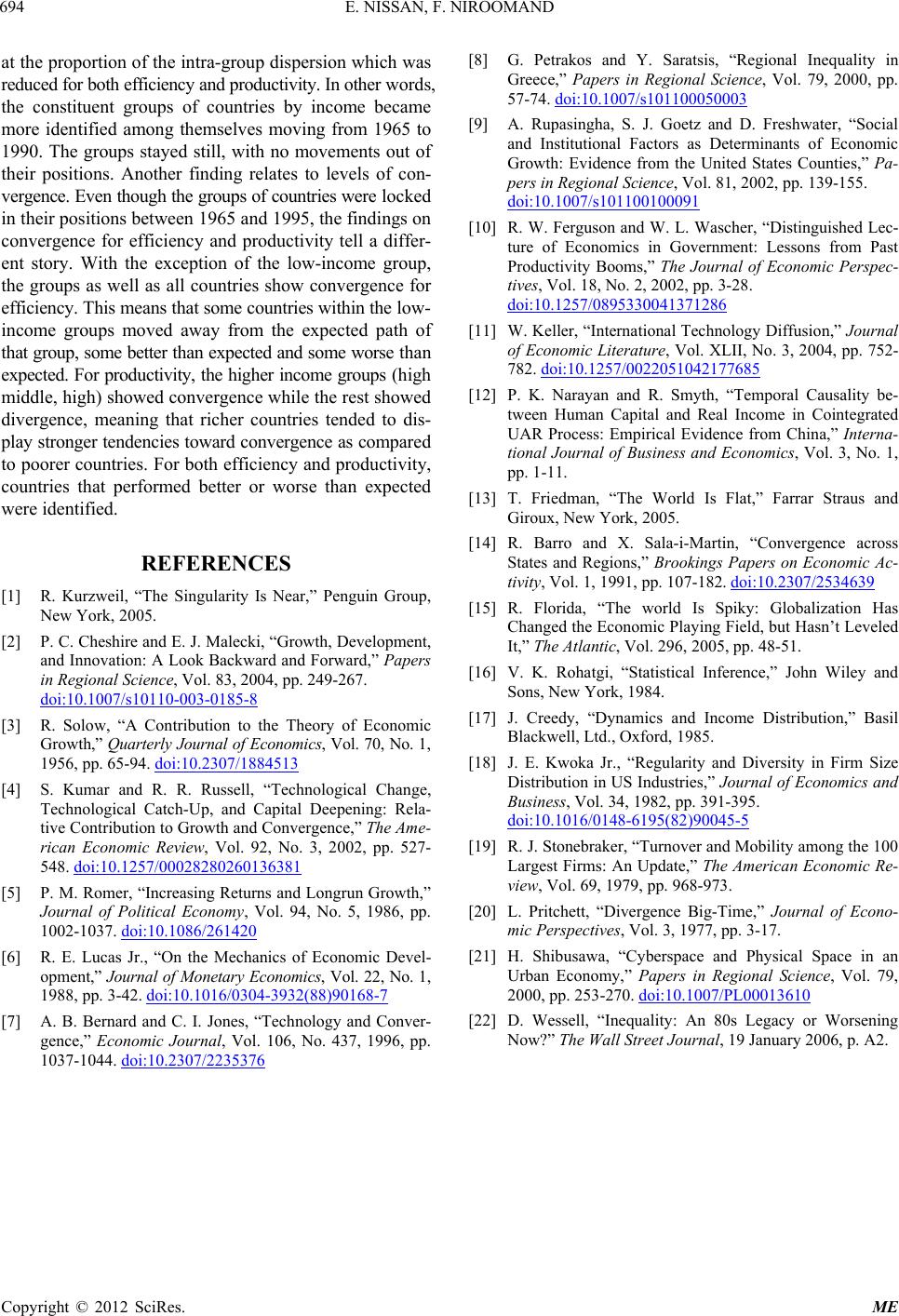
E. NISSAN, F. NIROOMAND
694
at the proportion of the intra-group dispersion which was
reduced for both efficiency and productivity. In other words,
the constituent groups of countries by income became
more identified among themselves moving from 1965 to
1990. The groups stayed still, with no movements out of
their positions. Another finding relates to levels of con-
vergence. Even though the group s of coun tries were lo c k e d
in their positions between 1965 and 1995, the findings on
convergence for efficiency and productivity tell a differ-
ent story. With the exception of the low-income group,
the groups as well as all countries show convergence for
efficiency. This means that some countries within the lo w-
income groups moved away from the expected path of
that group, some better than expected and some worse t ha n
expected. For productivity, th e higher income groups (hi gh
middle, high) showed convergence while the rest showed
divergence, meaning that richer countries tended to dis-
play stronger tendencies toward convergence as compar ed
to poorer countries. For both efficiency and productivity,
countries that performed better or worse than expected
were identified.
REFERENCES
[1] R. Kurzweil, “The Singularity Is Near,” Penguin Group,
New York, 2005.
[2] P. C. Cheshire and E. J. Malecki, “Growth, Development,
and Innovation: A Look Backward and Forward,” Papers
in Regional Science, Vol. 83, 2004, pp. 249-267.
doi:10.1007/s10110-003-0185-8
[3] R. Solow, “A Contribution to the Theory of Economic
Growth,” Quarterly Journal of Economics, Vol. 70, No. 1,
1956, pp. 65-94. doi:10.2307/1884513
[4] S. Kumar and R. R. Russell, “Technological Change,
Technological Catch-Up, and Capital Deepening: Rela-
tive Contribution to Growth and Convergence,” The Ame-
rican Economic Review, Vol. 92, No. 3, 2002, pp. 527-
548. doi:10.1257/00028280260136381
[5] P. M. Romer, “Increasing Returns and Longrun Growth,”
Journal of Political Economy, Vol. 94, No. 5, 1986, pp.
1002-1037. doi:10.1086/261420
[6] R. E. Lucas Jr., “On the Mechanics of Economic Devel-
opment,” Journal of Monetary Economics, Vol. 22, No. 1,
1988, pp. 3-42. doi:10.1016/0304-3932(88)90168-7
[7] A. B. Bernard and C. I. Jones, “Technology and Conver-
gence,” Economic Journal, Vol. 106, No. 437, 1996, pp.
1037-1044. doi:10.2307/2235376
[8] G. Petrakos and Y. Saratsis, “Regional Inequality in
Greece,” Papers in Regional Science, Vol. 79, 2000, pp.
57-74. doi:10.1007/s101100050003
[9] A. Rupasingha, S. J. Goetz and D. Freshwater, “Social
and Institutional Factors as Determinants of Economic
Growth: Evidence from the United States Counties,” Pa-
pers in Regional Science, Vol. 81, 2002, pp. 139-155.
doi:10.1007/s101100100091
[10] R. W. Ferguson and W. L. Wascher, “Distinguished Lec-
ture of Economics in Government: Lessons from Past
Productivity Booms,” The Journal of Economic Perspec-
tives, Vol. 18, No. 2, 2002, pp. 3-28.
doi:10.1257/0895330041371286
[11] W. Keller, “International Technology Diffusion,” Journal
of Economic Literature, Vol. XLII, No. 3, 2004, pp. 752-
782. doi:10.1257/0022051042177685
[12] P. K. Narayan and R. Smyth, “Temporal Causality be-
tween Human Capital and Real Income in Cointegrated
UAR Process: Empirical Evidence from China,” Interna-
tional Journal of Business and Economics, Vol. 3, No. 1,
pp. 1-11.
[13] T. Friedman, “The World Is Flat,” Farrar Straus and
Giroux, New York, 2005.
[14] R. Barro and X. Sala-i-Martin, “Convergence across
States and Regions,” Brookings Papers on Economic Ac-
tivity, Vol. 1, 1991, pp. 107-182. doi:10.2307/2534639
[15] R. Florida, “The world Is Spiky: Globalization Has
Changed the Economic Playing Field, but Hasn’t Leveled
It,” The Atlantic, Vol. 296, 2005, pp. 48-51.
[16] V. K. Rohatgi, “Statistical Inference,” John Wiley and
Sons, New York, 1984.
[17] J. Creedy, “Dynamics and Income Distribution,” Basil
Blackwell, Ltd., Oxford, 1985.
[18] J. E. Kwoka Jr., “Regularity and Diversity in Firm Size
Distribution in US Industries,” Journal of Economics and
Business, Vol. 34, 1982, pp. 391-395.
doi:10.1016/0148-6195(82)90045-5
[19] R. J. Stonebraker, “Turnover and Mobility among the 100
Largest Firms: An Update,” The American Economic Re-
view, Vol. 69, 1979, pp. 968-973.
[20] L. Pritchett, “Divergence Big-Time,” Journal of Econo-
mic Perspectives, Vol. 3, 1977, pp. 3-17.
[21] H. Shibusawa, “Cyberspace and Physical Space in an
Urban Economy,” Papers in Regional Science, Vol. 79,
2000, pp. 253-270. doi:10.1007/PL00013610
[22] D. Wessell, “Inequality: An 80s Legacy or Worsening
Now?” The Wall Street Journal, 19 January 2006, p. A2.
Copyright © 2012 SciRes. ME